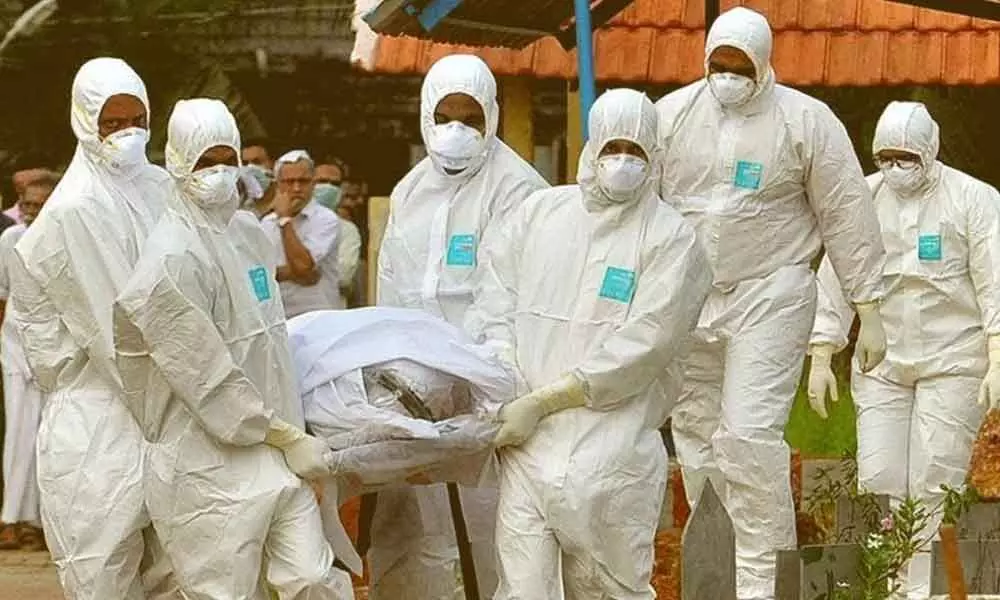Live
- KTR Condemns Arrest of Errolla Srinivas, Calls it an Unjust Act
- Meeting of Film Industry Leaders with CM Revanth Reddy
- Heavy Rush of Devotees at Tirumala Temple
- Belagavi meet is Jai Bapu-Jai Bhim-Jai Samvidhan convention
- Four Karnataka soldiers martyred in J&K Army vehicle accident
- Madhya Pradesh to translocate 14 tigers to Gujarat, Chhattisgarh, Odisha
- Shiva Rajkumar gets cancerous bladder removed in US
- Modi: Ambedkar's vision neglected by Congress
- With holiday mood on a high, hotel room demand peaks in Hampi
- Vajpayee’s statue unveiled in Berhampur
Just In
The Nipah scare: What went wrong in Kerala


The Nipah scare: What went wrong in Kerala
The failure to identify the primary source of Nipah virus in Kerala has been the most glaring omission and is a must to prevent further episodes of the infection, say health experts.
The failure to identify the primary source of Nipah virus in Kerala has been the most glaring omission and is a must to prevent further episodes of the infection, say health experts.
A zoonotic virus (transmitting from animal to humans), spread through contaminated food or directly between humans on exposure to secretions, Nipah has surfaced again in Kerala for the third time in a span of four years.
So far, the "fruit bat" has only been identified as the animal host reservoir from which the virus can spread the disease to other animals like pigs, dogs, cats, and goats. The recent death of a 12-year-old boy in Kozhikode marks Nipah's third attack in the state.
It was first confirmed in the Kerala district in May-June 2018 and claimed 17 lives. Fruit bats were suspected to have passed on the infection to the index case then, though no clear evidence was available.
"The failure to identify the source of the virus in the primary case in 2018 was a major drawback. The fact that the disease has resurfaced around Kozhikode region points to the fact that the virus is still endemic to the region," Dr Kiran G Kulirankal, Assistant Professor, Division of Infectious Diseases, Department of General Medicine, Amrita Hospitals, Kochi, told IANS.
Another sporadic case of Nipah resurfaced in June 2019 from Kochi, after about a year and at a geographically different location. Though the patient survived, the source of the infection was again not determined.
It was estimated that bats were infected with the Nipah virus and that bat-to-bat transmission was fast. The bats are only carriers and hence do not die. It is only when transmission to human beings happens that the threat arises.
"Lack of scientific proof of the primary source was glaring in both the episodes. When a similar epidemic in Malaysia occurred in 1998-1999, they could control the epidemic by determining that pigs were the intermediate host for Nipah, and large-scale culling and good animal farming practices prevented further occurrence," Dr Jitesh K., Senior Consultant, Internal Medicine, Meitra Hospital, Kozhikode, told IANS.
"Kerala can prevent further episodes by having clarity on the animal source infection," he added. However, the risk this time is much higher, since the attack is amid a Covid surge in the state as well as the region.
Can it surface as a co-infection? Experts suggest the possibility cannot be ignored. "The fact that the fatality rate for Covid 19 is between 1-2 per cent, while the fatality rate of Nipah varies between 40-75 per cent, is one to worry about. In a state already caught in a very serious battle against Covid 19, the outbreak came as a double blow," Kulirankal said.
"Early isolation and testing is the key to containment of the disease. The chances of co-infection are rare but cannot be ruled out," he noted.
The incubation period of the disease is 4 to 14 days and sometimes up to 60 days. The usual symptoms are fever, headache, sore throat, vomiting, and dizziness. As there is no cure or vaccine available till date, intensive supportive care is the mainstay treatment and only choice for treating severe respiratory or neurological complications, the doctors said.
In the current case, nearly 140 high-risk contacts of the deceased young boy have tested negative. But nearby states have been put on high alert for the disease. "The fight is still not over. The threat of another outbreak cannot be ruled out as long as the source remains unknown," Kulirankal said.
It is imperative for the state to "determine the source of Nipah whether it's a bat or some intermediate host like pigs or other wild animals", according to Jitesh. The state should also recognise that Nipah has become endemic, and all the breakouts happen mostly during May and December months so preventive activities should happen during these months, he added.
Public must be aware against trespassing into bat habitats and avoid eating contaminated fruits or interacting with domestic animals without proper protection.

© 2024 Hyderabad Media House Limited/The Hans India. All rights reserved. Powered by hocalwire.com






